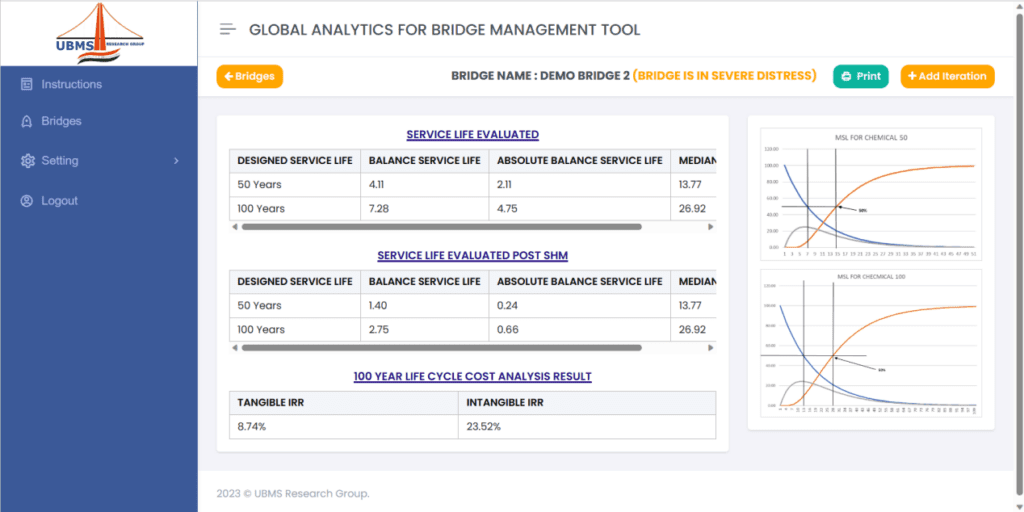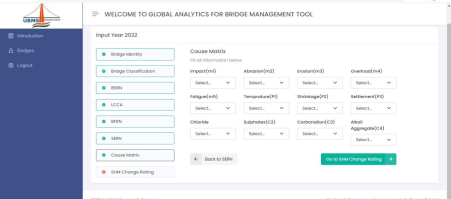In today’s scenario, climate changes have resulted in creating uncertainty in the way nature behaves. Natural hazards have become more unpredictable, more intense, and more frequent. To achieve or maintain sustainability of bridge structures under these circumstances is challenging but essential.
Bridges serve as essential parts of transportation infrastructure, facilitating the movement of people and goods across rivers, valleys, and other obstacles. However, they are also susceptible to floods, earthquakes, landslides, and other similar natural hazards. Impact of natural hazards is not predictable, sudden and can damage these bridge structures at times leading to failure of bridges. Such impacts cause severe economic and human losses. To address this issue, a proper mitigation or containment protocol is essential. Conventional Bridge Management did address this issue in a limited way.
UBMS Research Group [URG] dedicated their focus to evolve a solution to this challenging situation. URG has evolved an internet free, easy-to-implement and cost efficient Global Analytics for Bridge Management [GABM]. The new solution within GABM, offers a comprehensive solution to address the risk involved. Risk due to natural hazards cannot be eliminated totally but an effort has been initiated under the developed protocol to source a risk mitigation tool.
The application of risk indices for natural hazards in Bridge Management involves mathematical modelling application to data collected regarding occurrence of natural hazards, their intensity and frequency. The data collection process gathers information on the location, condition, and vulnerability of bridges, while mathematical modelling uses this data to assess the risk of natural hazards. Overall, risk indices provide a quantitative measure of the vulnerability of bridges to natural hazards and help to prioritize maintenance and repair activities. Mitigation measures are then evaluated and implemented based on the results of the risk assessment.
By using this tool, the URG has developed an algorithm for risk assessment which will be essential in the decision-making process, specifically focused on enhancing Fund Optimization arising due to deterioration modelling. This development also helps bridge managers to understand the potential threats posed by natural hazards and allocate resources more efficiently to ensure the safety and longevity of critical transportation infrastructure.

Risk assessment of natural hazards:
Natural hazards such as earthquakes, floods, hurricanes, and landslides can have devastating effects on human life and property. The frequency and severity of natural disasters have increased significantly in recent years due to factors such as climate change and urbanization. The management of natural hazards requires a proactive approach that involves the identification of vulnerable areas and the implementation of mitigation measures. Bridges are important infrastructure links. Their vulnerability is very high and needs special attention. The Bridge Management system needs to incorporate a module for such risk assessment and analysis. Based on the analysis, the proper action is required for the mitigation of the evaluated risks.
Risk index quantifies the probability and severity of a natural hazard occurring at a particular location. The risk index considers factors such as the probability of hazard occurrence, the intensity of the hazard, distance from the epicenter and the vulnerability of the population and infrastructure in the area. The risk index can be used to identify areas that are most vulnerable to natural hazards, prioritize mitigation measures, and evaluate the effectiveness of emergency response plans. Risk index is specific for the type of natural hazard. The index will be different for earthquake, landslide, flooding, cyclone, extreme temperature, or any other hazard.
The development of risk indices for hazards has become an essential component of hazard research and management. Risk indices have been used in the assessment of all major natural hazards including earthquake, flood, hurricane, landslide, and similar hazards. In each of these applications, the risk index provides a quantitative measure of the risk of a hazard occurring in a particular location and helps to identify areas that are most vulnerable to natural hazards.
Natural hazard module within GABM aims the utilization of risk indices for the natural hazards in the GABM application tool. Specifically, the module is focused on the methodology and usage of the risk indices for natural hazards in bridge management. The establishment of a risk index for hazards entails the use of mathematical models to quantify the likelihood and severity of a hazard occurring in a specific location. In the Global Analytics of Bridge Management, a risk index is used to assess the potential risks associated with bridges. This index combines information on the likelihood of an event occurring, its intensity, its proximity to the bridge and the consequences of that event. By considering all the factors, bridge managers can prioritize their resources and take appropriate actions to mitigate risks effectively during the decision-making process. Likelihood of the event occurring refers to the probability or frequency of the event occurring. For example, a bridge located in an area prone to earthquakes would have a higher likelihood of experiencing a seismic event compared to a bridge located in a seismically stable region.
Consequences refer to the impact of the event on the bridge if it were to occur. This includes the potential damage to the bridge, disruption to transportation networks, and potential loss of life or injuries. Consequences can vary based on the specific characteristics of the bridge, such as its structural design, materials used, and traffic volume.

To develop a risk index, bridge managers typically assign numerical values or ratings to both the likelihood, intensity, proximity, and consequences of various events. These ratings can be based on historical data, expert opinions, or analytical models. For example, likelihood ratings can be categorized as low, medium, or high, while consequence ratings can be classified as minor, moderate, or severe.
Once all the ratings are assigned, they are combined using a predetermined formula to calculate the risk index for each risk event. This formula can be as simple as multiplying the likelihood and consequence ratings together, or it can involve more complex mathematical calculations or statistical models. The resulting risk index provides a quantitative measure of the overall risk level associated with each risk event. GABM uses a mathematical model to evaluate the risk index.
Based on the risk index, bridge managers can prioritize their efforts and allocate resources accordingly. Risk events with higher indices indicate a greater need for immediate attention and mitigation measures. This allows bridge managers to develop risk mitigation and management strategies, such as conducting regular inspections, implementing maintenance programs, or prioritizing repair or replacement projects for bridges with the highest risk levels.
Overall, the risk index in GABM management provides a systematic approach to identifying, assessing, and prioritizing risks associated with the hazard to each bridge on the network. By utilizing this index, bridge managers can make informed decisions and take proactive steps to ensure the safety and longevity of bridge infrastructure. Mitigation principles involved are also based on taking a more proactive approach towards the vulnerability of the bridge to a particular hazard.
The protocol enables the bridge management to address the various issues involved more efficiently and effectively. We all understand that damage arising due to hazard cannot be avoided but can be restricted.
The benefits that can accrue are not possible without the below listed processes:
- Data Integration: The GABM tool integrates various data sources related to bridge infrastructure, hazard occurrences and the characteristics, and vulnerability assessments.
- Risk Assessment Modelling: The GABM tool utilizes advanced risk assessment models to quantify individual risk hazards. These models consider factors such as hazard probabilities, hazard intensities, proximity to past occurrences, bridge vulnerability, and potential consequences.
- Hazard Mapping: The GABM tool incorporates individual hazard mapping and has capabilities to present the spatial distribution of various risk hazards. Example one bridge could be more vulnerable to earthquakes and less or not vulnerable at all to floods and cyclones.
The resulting benefits to the region and bridges on the network are many. The below listing is the key benefit only. Many other ancillary benefits can culminate.
A] Prioritization and Resource Allocation: Based on the individual risk assessments, GABM module prioritizes bridges and allocates resources accordingly. It identifies bridges at higher risk from specific hazards and recommends mitigation measures, maintenance interventions, and resource allocation strategies.
B] Mitigation Strategies: GABM module guides mitigation strategies for individual risk hazards. This may include retrofitting measures, structural improvements, regular inspections, and maintenance actions tailored to the specific hazard types.
C] Decision Support: GABM module serves as a decision support system, enabling users to evaluate various scenarios and assess the effectiveness of different mitigation strategies.
D] Reporting and Documentation: GABM module generates comprehensive reports and documents summarizing the individual risk assessments, mitigation strategies, and recommended actions.
E] Continuous Improvement: GABM empowers continuous improvements and updates. It can be used as a feedback mechanism, data monitoring, and analysis of bridge performance during hazard events.
F] Comprehensive Risk Assessment: GABM provides a holistic, quantitative, and qualitative assessment of risk by considering multiple hazards, bridge vulnerabilities, and potential consequences.
G] Prioritization of Resources: GABM allows users, to prioritize resources based on the level of risk. Bridge managers can focus their efforts on bridges with higher risk levels.
H] Efficient Risk Mitigation: GABM facilitates the identification of specific risk factors and suggests appropriate mitigation strategies for each bridge, enabling bridge managers to implement targeted and cost-effective risk reduction measures.
I] Cost-Benefit Analysis: GABM, helps in cost-benefit analyses for bridge management and maintenance. By considering the potential risks and associated costs of bridge failures or disruptions, informed decisions can be made regarding investments in maintenance, repair, and retrofitting, ensuring optimal utilization of available resources.
J] Improved Decision-Making: GABM provides a standardized measure that can be used for comparative analysis and decision-making.
K] Enhanced Emergency Response Planning: During hazard events, GABM enables bridge managers to quickly identify bridges at higher risk, helping them prioritize emergency response efforts. This aids in evacuation planning, resource mobilization, and coordination with emergency management agencies.
L] Long-Term Planning and Resilience: GABM supports long-term planning. This assists in designing and implementing measures to enhance the resilience of bridges against evolving hazards and changing environmental conditions.
M] Stakeholder Communication: GABM provides a clear and easily communicable measure of risk. It facilitates effective communication with stakeholders, including bridge owners, government agencies, policymakers, and the public.
In conclusion it can be said that it is paramount important to incorporate the module for Risk assessment and mitigation within any Bridge management. GABM has provided the same to convey the importance of risk management, justifies the allocation of resources, and promotes transparency in decision-making processes.
URG aims to make this module available to all State and regional disaster mitigation authorities from October 13th 2023, which is the International day for Disaster Risk Reduction.
Authored by
Sachidanand Joshi, Head – UBMS Research Group (URG)
Atharvi Thorat, Harshali Dehadray, Mayuri Tundalwar – Research Engineers- URG

